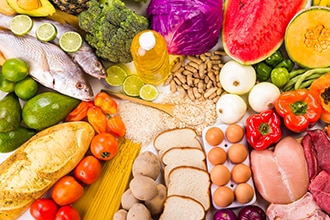
There are many delicious health foods that are nutritious and tasty. Including them in your diet will provide you with colorful, nutrient-rich meals that taste great. Among these foods are fruits, vegetables, nuts, seeds, and legumes. They are also tasty and require minimal preparation. Apples are the best choice as they are full of fiber, vitamin C, antioxidants, and other beneficial nutrients. They are easy to find in supermarkets and can easily be added to smoothies.
Prunes can also help maintain a healthy digestive system. They are high in fiber and antioxidants which make them great for the body. A quarter cup containing prunes contains 104 cals and 12% fibre. You can add them in your smoothies, cereals, and baked goods. They are also great in sauces and hummus. This makes them an ideal snack to include in your diet. They're also delicious and easily available.
There are many starchy vegetable options. These include sweet potatoes, carrots, squashes, pumpkins, corn and squash. These foods are great sources both of fiber and energy. They also contain a lot of B and zinc. They are great for your health and rich in iron as well as calcium. When you make them at home, compare their nutritional values with other brands.

Besides salads, you can also opt for grilled fish. The best fish to eat include salmon, mackerel (trout), mackerel), mackerel (sardines), tuna, mackerel), and mackerel. These fish are high in omega-3 fats, which are essential for cell membrane fluidity, signaling, and structural maintenance. They are also known to reduce the risk from heart disease, diabetes, and cancer.
Legumes are a good source of protein and dietary fibre, and can be eaten alongside fruits and veggies. These foods will keep your stomach fuller longer, and you won't snack between meals. These foods can be used as a substitute for meat and provide the same amount protein with no additional fat. Calcium-enriched alternatives are available if you don't want to eat dairy or meat. They contain 100 mgs of calcium per 100ml.
It is essential to choose the right foods. It is essential to eat fruits and veggies for good health. They are rich sources of vitamins, minerals, fiber, and other nutrients. It's important to choose the right kinds of fruit and vegetables to eat everyday. Remember to eat them every day as they are healthy for your body. And remember that the best way to do that is to eat as much of them as you can.
Another healthy food is yogurt. Yogurt has a high protein content and makes a great breakfast food. It also has a number of vitamins and mineral. It's also rich in soluble fibre, which is found naturally in whole grains, fruits and vegetables. To make the food more interesting, it's important that you mix different kinds of foods. Some prefer tea while others prefer coffee. Although coffee may not be as widely loved as tea, it does have many health benefits. It can improve energy levels, and reduce the risk of developing type II diabetes.

In addition to fruits and vegetables, people should eat more beans. Beans have low fat and high protein. They are also high in potassium, magnesium, fiber and protein. They're also rich in plant-based protein. They're also quite affordable. They can be used as side dishes and in salads. However, it's important to remember that too many people don't consume enough beans.
Beans and seeds are among the most important foods to eat everyday. They contain phytonutrients and fiber as well as B vitamins. And they're cheap. They can even help with weight loss and maintaining a healthy weight. And, you'll be eating a wide variety of healthy foods to eat every day. It is best to eat smaller portions if you can afford it. They are delicious, filling, and easy to make.
FAQ
How does an antibiotic work?
Antibiotics are drugs which destroy harmful bacteria. Antibiotics are used for treating bacterial infections. There are many different types of antibiotics. Some are administered topically, while others can be taken orally.
Many people who have been exposed can be prescribed antibiotics. To prevent shingles, an oral antibiotic may be prescribed to someone who has had chicken pox. Or, if someone has had strep throat, he or she might receive an injection of penicillin to help prevent pneumonia.
Doctors should prescribe antibiotics to children. Children are more susceptible to side effects from antibiotics than adults.
Diarrhea is the most common side effect from antibiotics. Other possible side effects include stomach cramps, nausea, vomiting, allergic reactions, headaches, dizziness, and rashes. These side effects usually disappear once treatment has ended.
What are the 10 most delicious foods?
These are the 10 best foods you can eat:
-
Avocados
-
Berries
-
Broccoli
-
Cauliflower
-
Eggs
-
Fish
-
Grains
-
Nuts
-
Oats
-
Salmon
How to measure body fat?
A Body Fat Analyzer can be used to measure body fat. These devices are used to measure body fat for people who want weight loss.
Here are 7 ways to live a healthy lifestyle.
-
Eat right
-
Exercise regularly
-
Sleep well
-
Make sure to drink plenty of water.
-
Get enough sleep
-
Be happy
-
Smile often
What is the best way to live a healthy lifestyle?
Healthy lifestyles include eating healthy food, regular exercise, good sleep, and avoiding stress. These are the keys to a healthy and long-lasting life.
Starting small can make a big difference in your diet, and even your exercise routine. Try walking for 30 minutes each day to lose weight. Swimming or dancing are great options if your goal is to become more active. You can also sign up for an online fitness program, such as Strava and Fitbit. This will track your activity.
Statistics
- nutrients.[17]X Research sourceWhole grains to try include: 100% whole wheat pasta and bread, brown rice, whole grain oats, farro, millet, quinoa, and barley. (wikihow.com)
- WHO recommends reducing saturated fats to less than 10% of total energy intake; reducing trans-fats to less than 1% of total energy intake; and replacing both saturated fats and trans-fats to unsaturated fats. (who.int)
- According to the 2020 Dietary Guidelines for Americans, a balanced diet high in fruits and vegetables, lean protein, low-fat dairy and whole grains is needed for optimal energy. (mayoclinichealthsystem.org)
- Extra virgin olive oil may benefit heart health, as people who consume it have a lower risk for dying from heart attacks and strokes according to some evidence (57Trusted Source (healthline.com)
External Links
How To
What does the word "vitamin" mean?
Vitamins can be described as organic compounds found in food. Vitamins aid us in absorbing nutrients from the food we eat. Vitamins cannot come from the body so food must provide them.
There are two types: water-soluble and fat-soluble vitamins. Water-soluble vitamins dissolve easily when they are dissolved in water. These include vitamin C (thiamine), Vitamin B1 (riboflavin), Vitamin B2 (riboflavin), Vitamin B3 (niacin), Vitamin B6 (pyridoxine), Vitamin C, B1 (thiamine), Vitamin B2 (riboflavin), Vitamin B3 (niacin), and Vitamin B6 (pyridoxine). Fat-soluble vitamins are stored in the liver, fatty tissue and kidneys. Examples include vitamin D, E, K, A, and beta carotene.
Vitamins are classified according to their biological activity. There are eight major vitamin groups:
-
A - vital for healthy growth.
-
C - important for proper nerve function and energy production.
-
D - necessary for healthy bones and teeth.
-
E - Required for good vision & reproduction
-
K – Required for healthy nerves & muscles.
-
P - Essential for strong bones and teeth.
-
Q - aids digestion and absorption of iron.
-
R - necessary for making red blood cells.
The recommended daily intake (RDA), of vitamins varies with age, gender and physical condition. The U.S. Food and Drug Administration has established the RDA values.
For adults aged 19 and older, the RDA for vitamin B is 400 micrograms daily. Pregnant women require 600 micrograms daily to support fetal development. Children ages 1-8 require 900 micrograms per day. Children under 1 year old require 700 micrograms daily, while infants over one year old need 500 micrograms every day. This decreases between 9 and 12 months.
Children ages 1-18years who are obese need 800 micrograms per day while those who are overweight need 1000 micrograms per day and children who are underweight need 1200 micrograms per day to meet their nutritional needs.
2200 mg of vitamin A per day is required for children aged 4-8 who have been diagnosed by anemia.
2000 micrograms is the minimum daily intake for adults over 50 years old to maintain good health. Because of their higher nutrient needs, women who are pregnant or nursing need 3000 mg per day.
1500 micrograms are required daily by adults over 70 because they lose approximately 10% of their muscle each decade.
Women who are pregnant, nursing or breastfeeding need more than the RDA. Pregnant women need 4000 micrograms per dayduring pregnancy and 2500 micrograms per day after delivery. Breastfeeding mothers need 5000 micrograms per day when breast milk is being produced.